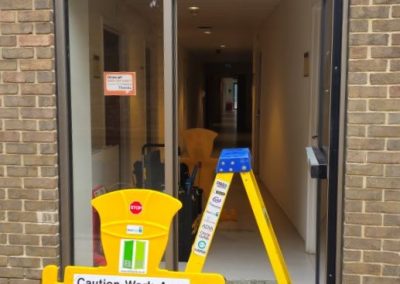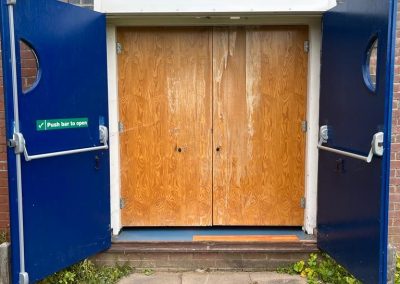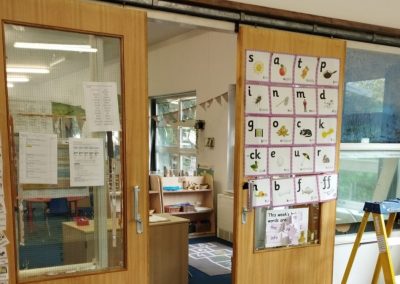
Fire Exits & Escapes Service & Maintenance
Fire doors are an essential part of any building and fall into 2 categories, either internal or external.
EXTERNAL FIRE DOOR
An external fire door, typically known as a fire escape, fire exit, emergency door, emergency escape door, panic bar door or emergency exit door are installed on the outside perimeter of a building.
An emergency fire exit door usually serves as the final opening to the outside of the building which is designated by an Emergency Exit which is illuminated.
They easily opened via a panic bar or push pad from the inside in the event of an emergency, or can also be opened from the outside required using an external access device.
They can be manufactured out of glass, aluminium, timber or steel depending on the location, security requirements or size.
INTERNAL FIRE DOOR
An internal fire door, typically known as a wooden door, timber door, corridor door is a fire-resistant, safety utility designed to prevent the spread of fire within a building long enough to save lives and crucial properties / documents. Typically, these are manufactured from timber and maybe situated in corridors or entrance doors to rooms.
Fire doors are specialist doors which have been tested against the elements and purpose-built to withstand fires for as long as possible, either 30, 60 or 120 minutes. They enable buildings to compartmentalise and delay the spread of fire from one area to another, and form a crucial part of a passive fire protection strategy. These are designated by either a Fire door keep closed or keep locked sign on both sides of the door.
- Planned in advance at your most convenient time
- Specific schedule of works
- Risk assessment and safety checklist
- Test operation for safe escape
- Minor repairs included
- Adjust speeds of floor spring / transom closer / overhead closer if required
- Separate quotation for defects or recommendations
- Prioritise quotations on multiple door sites
Why have your fire escape or emergency exit serviced?
The purpose of an emergency exit in a building is a special exit for emergencies such as a fire: the combined use of regular and special exits allows for faster evacuation, while it also provides an alternative if the route to the regular exit is blocked by fire, etc.
For compliance to BS9999, fire escapes should be serviced and inspected every 6 months.
This may also be a stipulation of your building insurance, your lease agreement or part of your Fire risk assessment for your fire exits to be maintained.
When carrying out a service we have a specific schedule of works which includes adjustments and minor repairs. This may be to adjust the closing speed if a door closer such as a transom, overhead or concealed type is fitted.
It is also important to test and check the operation as there are maximum forces to open these types of doors, so all engineers carry force gauges on their vans for this purpose.
We documented our findings on our Risk Assessment Checklist for each door so you have a record and documented evidence as this may form part of their fire risk assessment.
Any repairs or defects which could not be rectified at the service were provided by means of a separate quotation per door to allow you to put a plan in place for the repairs and spread the cost.
SPECIFICATION
REPAIR
SERVICE
DOCUMENTATION
RISK ASSESSMENT
PRICE
We provide service contracts and preventative maintenance on a range of manufacturers equipment. From a one-off service to 3-year fixed cost contract, call us on 0808 1200911 to discuss your requirements.

FAQs
How often should commercial doors be serviced, especially those in high-traffic areas?
Our preventative maintenance contracts ensure fixed service costs, safety risk assessments, building compliance, and an asset register to track each door’s condition. For especially busy sites, internal basic inspections (weekly/monthly) complement the bi‑annual professional service. This combined approach ensures early detection of wear or misalignment and helps avoid unplanned downtime or costly emergency repairs.
What does a typical commercial door maintenance service include?
Local qualified engineers perform tests, carry out minor repairs, evaluate alignment, functionality and safety features, and supply risk assessments and method statements. Reduced rates apply under contract, and service includes compliance with relevant regulations (e.g. EN16005, BS7036, Document M, DDA, BS9999).
Can you provide a detailed maintenance checklist for our specific type of commercial doors?
It also includes risk assessment and method statement documentation. Contract customers receive the checklist in advance, ensuring they understand required work. The checklist supports preventive maintenance and forms part of compliance records and building audits.
What are the best practices for lubricating moving parts of a commercial door?
They avoid lubricating sensor lenses or electrical parts to maintain safety compliance. Regular scheduled servicing (e.g. every six months or as per contract) includes lubrication, while internal staff are encouraged to monitor for stiffness or noise and report issues promptly.
How can regular cleaning and inspection prevent common door issues?
Documentation via asset register and risk assessments helps track recurring issues and inform preventive measures. The combination of clean components and thorough inspection prevents emergency call‑outs, extends equipment life, and ensures consistent performance across door types.
Do you offer scheduled maintenance contracts or service level agreements (SLAs)?
Customers benefit from predictable budgeting, priority scheduling, and long‑term reliability. Emergency services remain available with fixed call‑out fees. Contracts ensure consistent high‑quality service and peace of mind.
How often should safety features like sensors and emergency stops be tested?
Risk assessments include retesting safety mechanisms after any repair. Between visits, staff should report sensor or safety anomalies immediately. Following incidents or maintenance, BH Doors will re‑test upon request or during the next service.
What are the key indicators that suggest immediate professional maintenance is needed?
BH Doors & Engineering Ltd H Doors provides fast-response emergency repairs with a fixed call‑out fee, local engineers, spare parts in stock, and rapid turnaround. Customers can call for urgent assistance ahead of scheduled visits if any of these indicators emerge to avoid hazards or downtime.
How does proper maintenance contribute to the longevity and energy efficiency of commercial doors?
Documentation and asset tracking ensure maintenance is proactive. This approach supports longevity, performance consistency, and energy savings—especially crucial for automatic, aluminium, glass, and fire-rated doors operating in diverse environments across their service area.
What steps can our internal staff take to perform basic daily or weekly checks?
BH Doors & Engineering Ltd advises internal site staff to conduct basic checks between scheduled services: visually inspect doors for misalignment or damage; clear debris from tracks; test smooth operation; clean sensor lenses; verify seals; listen for unusual noises; check closing speed and full sealing; test manual overrides or emergency stops; and report irregularities promptly.
These actions help ensure optimal day‑to‑day performance and facilitate timely professional intervention during service visits or emergency repairs.
What specific cleaning products and techniques are recommended for different door materials (e.g., aluminium, glass, steel)?
BH Doors & Engineering Ltd recommends mild, non-abrasive, pH-neutral cleaners suitable for the material: diluted mild detergent and soft cloth for aluminium; glass cleaner and microfiber cloth for glass; pH-neutral cleaner for steel (no steel wool); gentle cleaners for painted surfaces.
Avoid aggressive acids or alkalis that may damage seals or finishes. These are applied during service visits or by facilities staff and maintained in a clean condition to support proper function and appearance.
How do environmental factors (e.g., temperature changes, humidity) impact door performance and maintenance needs?
Their services across regions Bedfordshire, Berkshire, Buckinghamshire, Cambridgeshire, Essex, Hertfordshire, Leicestershire, Medway, Norfolk, Northamptonshire, Oxfordshire, Suffolk, Warwickshire, Wiltshire. include tailored assessments to address local conditions, material suitability, and maintenance
frequency.
High‑humidity or dust‑prone sites may warrant more frequent servicing or specialized components. Risk assessments identify environmental risks and adaptive measures to maintain safety and performance.
What are the benefits of professional inspections versus in-house checks?
Our engineers carry spare parts, certified expertise, and can remedy hidden electrical or mechanical faults. Service contracts provide asset tracking and risk assessments. Combined, in‑house vigilance and expert servicing ensure optimum performance, safety, longevity, and compliance beyond what either alone can deliver.
Do you keep a record of past services and repairs for our doors?
Contract customers benefit from documentation of each maintenance action, building compliance records, and historical performance insights. These records aid audit readiness, trend analysis, and planning for component replacement.
What preventative measures can be taken to avoid common wear and tear issues?
Safety risk assessments guide installation of edge guards, sensors, or seals tailored to environment. With prompt minor repairs and documentation, common wear issues like seal failure, misalignment, sensor damage are mitigated before escalating.

Modern Art Oxford
“Yes I would recommend them too – really professional and competitive, much better than larger national companies I’ve used before.”

Parkway Shopping Centre
“BH doors have demonstrated professionalism, excellent customer service and super quality of repairs. I thank you for making my role easier. I only wish I could persuade my company to deal with you all the time.”

Mainstay Group
“Just thought I would drop a line and thank you for the help today, exceptional services as normal.”
Fire Exit & Escape Door Projects





